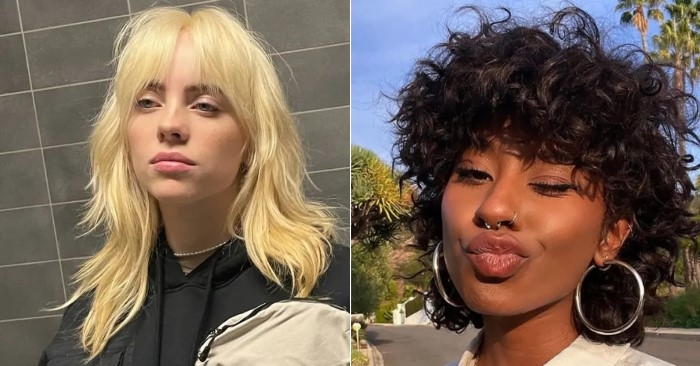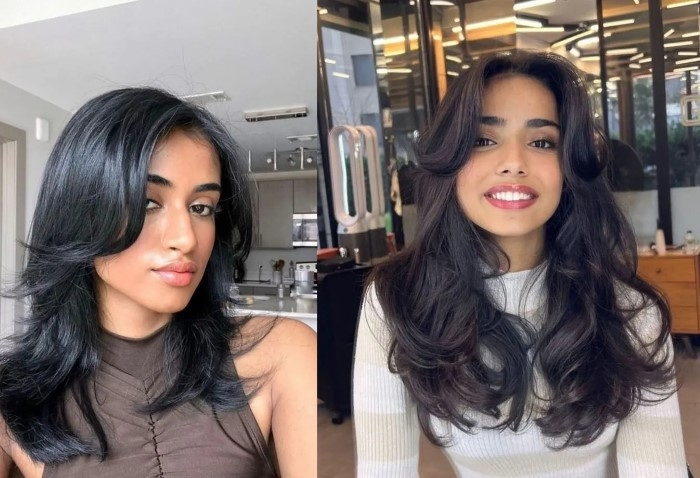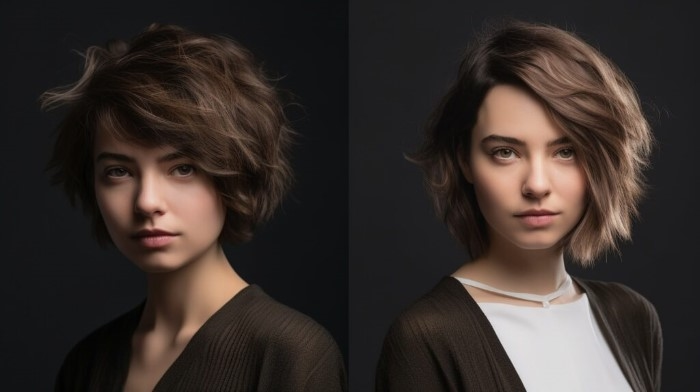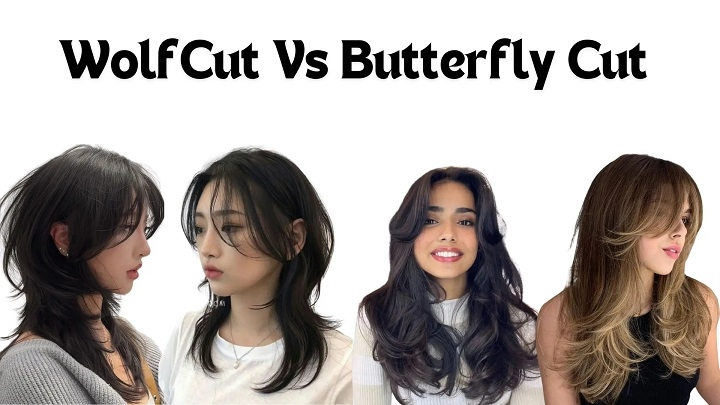Hairstyles always change, and among the most famous ones in the current environment are the wolf cut and the butterfly cut. Both provide the layered and textured appearance and vary in structure, volume and versatility of styling. It may be tricky to select one, in case you want to combine the new fashion style and practicality. This guide gives you the breakdown of the differences, advantages and considerations to determine the best cut that will fit your personality, face shape as well as the hair type.
What Does Wolf Cut Mean?

The wolf cut is a style that is a cross between a shag haircut and a mullet, resulting in a zany, voluminous and sharp looking hairstyle. It is characterized by:
- On the crown height and motion, heavy layers.
- Longer back parts that go beyond the shoulders.
- Beaded, raggedy ends which look messy and tangled.
- Face-framing layers that blur attributes or hike cheekbones.
Wolf cuts can be done on straight, wavy, and curly hair. The focus on texture provides a low maintenance option and is therefore ideal particularly to someone who dislikes a seamless approach.
What is a Butterfly Cut?
The butterfly cut is a layered haircut that is created with the aim of having soft and wing-like movement just like the softness of the butterfly wings. It is typified by:
- Less extended layers that outline the face.
- The back layers should be longer in order to be long and flowing.
- Soft-cut ends (so they would not be bulky) or feathered ends.
- A lift up at the crown to add dimension, never bulk.
The butterfly cut brings out the natural hair curl patterns on curly and wavy hair, and maintains structural style. It is more elegant and symmetrical and can be compared to the wolf cut, except that it looks more polished.
Key Differences Between Wolf Cut and Butterfly Cut

| Feature | Wolf Cut | Butterfly Cut |
| Texture | Messy, choppy, tousled | Smooth, feathered, wing-like |
| Volume | Heavy at crown and top | Moderate crown lift |
| Length | Longer back, shorter front optional | Short front layers, longer back layers |
| Face Framing | Optional, choppy | Always designed to frame the face |
| Maintenance | Low-maintenance messy style | Medium-maintenance structured style |
| Hair Type | Straight, wavy, curly | Straight, wavy, curly, fine hair |
| Vibe/Style | Edgy, youthful, modern | Elegant, feminine, soft |
Pros and Cons
Wolf Cut
Pros:
- Chic, rock and daring
- Multi hair textures works
- Minimal decoration to have clutter and lived in.
- Adds beautiful volumizing to skin No greasy products
Cons:
- It can be untidy unless exhibited well
- Unsuitable to professional or formal contexts
- Needs trimming every now and then to avoid the overgrowing layers
Butterfly Cut
Pros:
- Sophisticated and yet flexible
- Provides delicate, face framing thickness
- Adds curl and waves that occur naturally
- Can be BOTH casual and formal
Cons:
- Is harder to keep in shape
- Needs crisp cut offs to maintain layered appearance
- May not be so good very coarse or very short hair
Face Shape Considerations
Wolf Cut
- Oval shape: This shape works well and adds some structure without overpowering features.
- Round face: The face is lengthened by adding height to the crown.
- Square face: Dampened waves smooth sharp jaws.
- Heart-shaped face: Long hair covering the back forms a counter in a broader forehead.
Butterfly Cut
- Oval face: Holds exceptional symmetry, and brings out the cheekbones.
- Round face: Longer layers in the back and short layers towards the front makes the face slimmer.
- Square face: Angular jaws are made soft with cup-like edges and layers.
- Heart-shaped face: Raises crown, and frames face to equal the proportions.
Suitability on Hair Type

Wolf Cut
- Straight hair: Choppy layers are used to increase volume.
- Wavey hair: Increases natural movement.
- Curly hair: Provides larky, dishevelled effect.
Butterfly Cut
- Straight hair: Layers have the appearance of wings, smooth and well-groomed.
- Hair: Wavy- gives a natural bounce and flow.
- Curly hair: Forms curls and avoids weight.
Styling Techniques
Wolf Cut
- Texturizing scissors to make them even choppier.
- Use volumising mousse or light gel.
- Finger-style to give a sloppy casual appearance.
- Optional: Curl as desired to give texture to ends.
Butterfly Cut
- Blow-dry using a round brush to give a crown lift.
- Use product: apply light curl cream/leave in conditioner.
- The scissors are used to have a soft ending of the feather.
- Additional: Slice layers to get a sleek elegant appearance.
Maintenance Tips
Wolf Cut
- Cut back after 8 to 10 weeks to avoid uneven growth.
- Apply light weight styling products to keep the texture.
- Hair can be aired off or diffused to look natural with a messy vibe.
Butterfly Cut
- Every 68 weeks cut down to maintain winged layers.
- Wavy or curly styles are deep conditioned once every week.
- Apply heat protectant when using blow dryer or iron curling.
- Stay away from heavy products which level layers.
Popular Variations
Wolf Cut
- Shaggy wolf cut: That includes additional textured layers to achieve utmost volume.
- Curly wolf cut: Makes craziness with an underpinning of natural curls.
Butterfly Cut
- Short butterfly cut: Keeps the beauty in unique shape, and makes hair much manageable.
- Long butterfly cut: Brings about movement and dimension.
Styling for Occasions
- Casual Look: Tousled wolf cut with minimal product or butterfly cut air-dried for natural waves.
- Professional Look: Smooth butterfly cut with blow-dried layers.
- Evening/Event Look: Wolf cut with textured waves or butterfly cut enhanced with light curls or highlights.
Choosing Between Wolf Cut and Butterfly Cut
When deciding, consider:
- Lifestyle: Wolf cut is low-maintenance and playful; butterfly cut is structured and elegant.
- Hair Texture: Thick or curly hair may suit both, but butterfly cut gives more controlled volume.
- Face Shape: Both cuts flatter different face shapes differently; consider which best enhances your features.
- Styling Preference: Wolf cut thrives on messiness, butterfly cut requires styling finesse.
FAQs — Wolf Cut vs Butterfly Cut
Will curly hair work on both cuts?
Of course, but butterfly cuts form curls in a much softer way whereas wolf cuts wear the wild volume.
Which cut is less work to keep up?
Wolf cut is less-maintaining because of its messy-tossed style. Butterfly cut should be trimmed and set.
May I touch these cuts in some color?
Yes, highlights, balayage or pastel green and blue give both cuts a stronger emphasis on layers and volume.
What cut would better fit a professional situation?
Butterfly cut is graceful and glossy, and thus it will fit better at a formal event.
Do both cuts suit short, medium and long hair?
Well yes, the wolf cut can tend to be more dramatic with the longer layers in them but the butterfly cut can be used on all lengths.
Both the wolf cut and the butterfly cut are fashionable layered hair styles of a different personality. The wolf cut has a daring, sloppy, and edgy style, so it is well suited to a young or carefree look. Butterfly cut in its turn offers a structured organization of layers, sophisticated look, and the restrictified amount of volume that enhances the texture of natural hair. In selecting it, you have to look at face shape, hair type, lifestyle and maintenance preference. Achieved with the proper cut and styling regimen to compliment your features, both styles can add dimension, make your face pop and give you a polished overall appearance.

